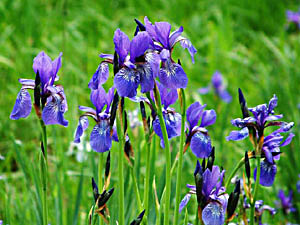
medicinal herbs
Siberian Iris
Iris sibirica

Herb: Siberian Iris
Latin name: Iris sibirica
Family: Iridaceae (Iris Family)
Medicinal use of Siberian Iris:
Expectorant.Description of the plant:

Plant:
Perennial
Height:
60 cm(2 feet)

Flowering:
JuneHabitat of the herb:
Damp woodland, pastures and heaths.Edible parts of Siberian Iris:
Root - an edible starch is said to be extracted from it. The root is not eaten in China. Some caution is advised since there are reports that the plant might be poisonous. Perhaps the extracted starch is edible.Other uses of the herb:
An insecticide is obtained from the plant. (from the root?)Propagation of Siberian Iris:
Seed - best sown as soon as it is ripe in a cold frame. Stored seed should be sown as early in the year as possible in a cold frame. Prick out the seedlings into individual pots when they are large enough to handle and grow them on in the greenhouse or cold frame for their first year. Plant out into their permanent positions in late spring or early summer. Division, best done in August/September after flowering but can also be done in April. Very easy, larger clumps can be replanted direct into their permanent positions, though it is best to pot up smaller clumps and grow them on in a cold frame until they are rooting well. Plant them out in the spring.Cultivation of the herb:
Damp woodland, pastures and heaths.Known hazards of Iris sibirica:
Many plants in this genus are thought to be poisonous if ingested, so caution is advised. The roots are especially likely to be toxic. Plants can cause skin irritations and allergies in some people.Plant information taken from the Plants For A Future.
